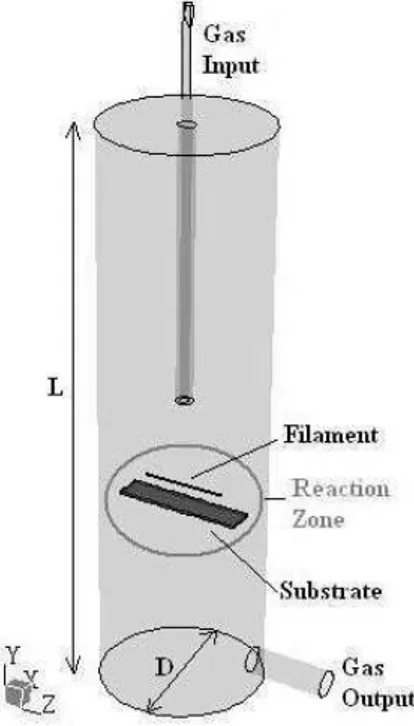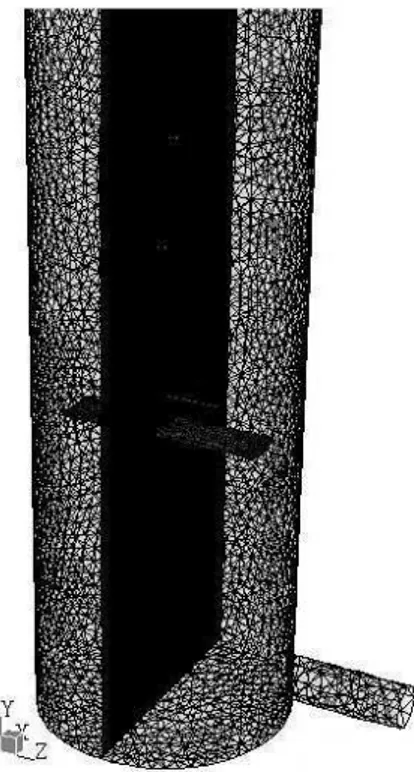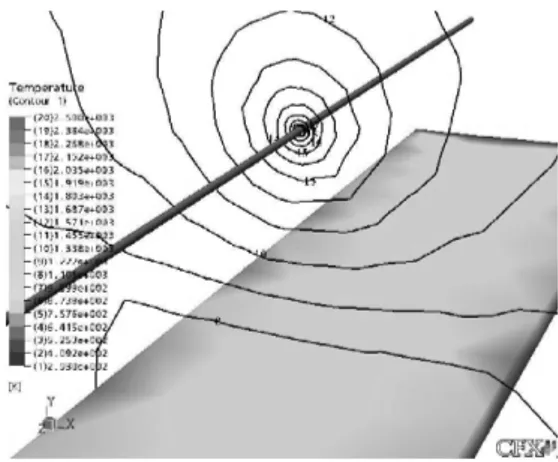Brazilian Journal of Physics, vol. 36, no. 2A, June, 2006 313
Numerical Simulation of HFCVD Process Used for Diamond Growth
Divani C. Barbosa∗, H´elcio F. V. Nova†, and Mauricio R. Baldan∗ Instituto Nacional de Pesquisas Espaciais,
∗Laborat´orio Associado de Sensores e Materiais and
†Laborat´orio Associado de Computac¸˜ao e Matem´atica Aplicada,
Caixa Postal 515, 12245-970 S˜ao Jos´e dos Campos-SP, Brazil
Received on 4 April, 2005
Hot-filament chemical vapour deposition (HFCVD) is a common method employed for diamond deposition. Typically in this method a dilute mixture of carbon containing gas such as methane in hydrogen is thermally activated at sub atmospheric pressures by a hot filament. Due to the filament-substrate proximity, large tem-perature variation across the substrate is possible. In this work we investigate the role of fluid flow and heat transfer from the filament to substrate in determining the quality of diamond growth. The commercial software CFX was used to calculate velocity field, temperature distribution and fluid flow. A vortex was identified on the substrate.
Keywords: Numerical simulation; Diamond growth; Hot-filament chemical vapour deposition
I. INTRODUCTION
In the past few years there has been considerable increase in the study of polycrystalline diamond film. The impetus for theses studies has been provided by the discovery that diamond film can be grown on a variety of substrates under metastable conditions [1-3]. Diamond film have now been grown using a variety of deposition techniques and under a wide range of conditions. Diamond is a material of many unique properties. It is de hardest substance known to man, has the highest thermal conductivity of any known mater-ial at room temperature, is transmissive over a wide spectral range, highly inert and a good electrical insulator. Its prop-erties have created potential opportunities for diamond in tri-bological, optical, microelectronics, thermal management and coating applications among other [2, 3]. Many of these po-tential applications can be realized by using diamond films obtained from chemical vapour deposition. Since, in most of these methods diamond films are deposited in sub atmospheric pressures and relatively low substrate temperatures, it is antic-ipated that many of the unique mechanical and optoelectronic properties of diamond can now be commercially exploded [4]. This work is based in the technique of chemical vapour depo-sition (CVD). In the CVD reactor a mixture of the gases is introduced, cross de activation source (filament) where the re-action take place (rere-action zone) and produce the precursor species that are transported to the surface of the growth and then react to form diamond. The reactor geometry is shown in the Fig. 1.
The CVD is an important process for fabricating microelec-tronic circuits. A wide variety of semiconductors can be made using this process, and a large degree of control can be exerted over the deposition by altering the composition and concen-tration of active species in the gas phase. Individual layers of material can be deposited on a substrate by introducing vari-ous active species into the gas stream in the desired sequence and the rates of deposition with CVD can be of the order of microns/minute. Although, the potential exists for obtaining uniform deposition, the deposition process is dependent on
the flow and the heat transfer from filament and substrate to the gas. The complexity of CVD processes is caused by the interdependence of the three main stages which determine the deposition: transport of the reactive species to the surface, chemical reaction on or near the surface and the transport of the reaction products from the surface [5]. The flow of the gas plays an important role controlling the rate and uniformity of deposition, because it governs the supply of reactants to the substrate that may be limited by mass transport. In this paper we analyze the fluid flow and the temperature distribution on the substrate. The computational task involves solution of a set of partial differential equations representing the essential physical features of the process.
314 Divani C. Barbosa et al.
II. MATHEMATICAL MODEL AND CALCULATION METHOD
The mathematical model can be described by the governing partial differential equations, i.e., the equations of conserva-tion of momentum, mass, and heat. For a concrete reactor a 3D model was solved together with other physical input nec-essary to define the system adequately.
Continuity equation:
∇·(ρ~v) =0,
Momentum equation:
∇·(ρ~v~v) =∇·µh(∇~v) + (∇~v)Ti+∇
·µ
µ′
−2
3µ∇·~v ¶¸
−∇p+ρ~g,
Energy equation:
Cp∇·(ρT~v) =λ ¡∇2T¢
,
Where:ρis the density of the fluid, v the velocity vector, Cp the specific heat, T the temperature,λthe diffusion coefficient and µ the viscosity coefficient.
The following assumptions are made for the model formu-lation: (1) the flow of the gas mixture in the reactor is lami-nar. This is a realistic assumption, since flow in CVD reactor is normally slow and laminar to insure uniform film growth. (2) Binary diffusion coefficients are used in the hydrogen car-rier gas mixture. This assumption is valid, because the more conventional techniques frequently utilizes CH4as a carbon-bearing feedstock and dilute this gas with large amounts of H2to achieve inlet gas mixtures containing less than 1 mol % CH4.(3) No chemical reaction takes place in this model. The calculations were performed with the geometry shown in Fig. 1. In the calculation a single straight filament of the di-ameter 0.25 microns was held 7mm above the substrate. The temperature of the substrate and filament were maintained at 1000K and 2500K respectively. The operating pressure was 4.0·103Pa (30 Torr) and the walls were maintained at the tem-perature 328K. The gas flow rate is≈100 cm3min−1. The simulation was performed using CFX [6], a commercial code which employs finite volume. The mesh grid used has 2·106 nodes with tetrahedral elements. Fig. 2 shows the superficial mesh used in the discretization of the equations. Fig. 3 shows x-y plane. Fig. 4 shows in details the grid mesh used between the filament and substrate.
III. RESULTS AND DISCUSSION
When a mixture of hydrogen and methane comes near the hot filament, the temperature and consequently its composi-tion changes. Temperature, pressure and flow composicomposi-tion are very important factors responsible for the amount of various
FIG. 2: Superficial mesh grid.
FIG. 3: x-y plane of the reactor geometry.
Brazilian Journal of Physics, vol. 36, no. 2A, June, 2006 315
FIG. 4: Reaction zone of the grid mesh (detail of the substrate – filament).
FIG. 5: Temperature distribution in the reaction zone.
primary factor in establishing the temperature field [7]. Fig. 6 shows a comparison of a calculated temperature and two ex-perimental results. It is observed that the computed values are in good agreement with the experimental observations [4, 8]. In the Fig. 7 is showed the velocity field profile. A pair of the vortex appears beside the filament and indicates the
pres-FIG. 6: Temperature profile between filament and substrate, compar-ison of simulated temperature with experimental results.
FIG. 7: The velocity field profile in the reaction zone.
ence of natural convection. With the help of a dimensionless number, the Peclet number for mass transfer, it is possible to understand the importance of the mass transport by convec-tion and diffusion. The Peclet number is defined as the ratio of convective mass transfer to diffusive mass transfer and is given by Pe=uα/Di j. Where u is the average velocity,αis a
characteristic length, and Di j is the diffusion coefficient and
depends on the nature of the species, temperature, pressure and composition. The calculation of Di j takes into account
the assumption (2) made above. From the Fig. 7 is also possi-ble to estimate the velocity near the filament≈0.02m/s. Us-ing this velocity as average velocity, the characteristic length as the distance between the filament and substrate, 7mm, and the average temperature between the substrate and filament, 1750 K, the Peclet number calculated for the system was≈ 4·10−4. This value indicates that diffusive mass transport is the dominant mechanism. A close look in Fig. 7 shows that the vortex velocity is too small to contribute with the mass transport. The Ref. [8-9] investigated the role of fluid flow and heat transfer in determining the quality of the diamond film. In these papers, experiments were conducted with vari-ous flow configurations. The authors have concluded that the convection play no role in the rates deposition. But this papers does not show the vortex caused by the natural convection and also do not measure the velocity of the vortex to verify the ef-fective contribution.
IV. CONCLUSION
316 Divani C. Barbosa et al.
Acknowledgement
We are gratefully to FAPESP and CNPq, by the financial support of this work, under contract no 02/12578-2 and no
140243/2004-6 respectively.
[1] J. C. Angus and C. C. Hayman, Science. 241, 913 (1988). [2] P. W. May, Phil. Trans. R. Soc. Lond. A. 358, 473 (2000). [3] S.-T. Lee, Z. Lin and X. Jiang, Mater. Sci. Eng. 25, 123 (1999). [4] C. Wolden and K. K. Gleason, Appl. Phys. Lett. 62, 2329 (1993). [5] G. Wahl, Thin Solid Films. 40, 13 (1977).
[6] ANSYS Company, CFX-5 Solver Theory Manual CFX Ltd.,
ANSYS Company, Oxfordshire (2003).
[7] K. Tankala and T. DebRoy, J. Appl. Phys. 72, 712 (1992). [8] K. Tankala and T. DebRoy, Surf. Coat. Technol. 62, 349 (1993). [9] T. DebRoy, K. Tankala, W. A. Yarbrouugh and R. Messier, J.


